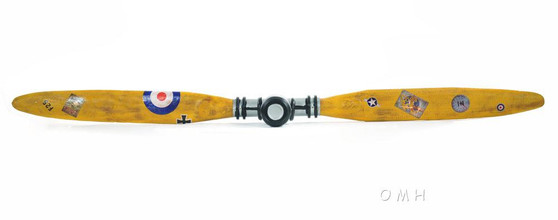This Beautiful Airplane Propeller Wall Decor "AJ001" Is Presented By Old Modern Handicrafts. Nothing captures the spirit and nostalgia of the World War I era like this timeless antique propeller. At approximately 79 inches long, this decor piece is perfect for an aviation expert or collector. This vintage propeller is an exact replica of an original propeller from the World War I era. It features solid wood with brass accents and unique designs. A must have for the collector and enthusiast!
Aircraft propellers or airscrews convert rotary motion from piston engines, turboprops or electric motors to provide propulsive force. They may be fixed or variable pitch. Early aircraft propellers were carved by hand from solid or laminated wood with later propellers being constructed from metal. The most modern propeller designs use high-technology composite materials. The propeller is usually attached to the crankshaft of a piston engine, either directly or through a reduction unit. Light aircraft engines often do not require the complexity of gearing but on larger engines and turboprop aircraft it is essential.| GENERAL INFORMATION |
| SKU | AJ001 |
| Manufacturer | Old Modern Handicrafts |
| Category | Nautical |
| UPC | 640901135007 |
| Ship Via | FedEx |
| Dimensions | 5W x 79L x 10H Inches, Weight 7 Lbs |
| Carton Dimensions | 12W x 51L x 7H Inches, Weight 11 Lbs |
| History | Aircraft propellers or airscrews convert rotary motion from piston engines, turboprops or electric motors to provide propulsive force. They may be fixed or variable pitch. Early aircraft propellers were carved by hand from solid or laminated wood with later propellers being constructed from metal. The most modern propeller designs use high-technology composite materials. The propeller is usually attached to the crankshaft of a piston engine, either directly or through a reduction unit. Light aircraft engines often do not require the complexity of gearing but on larger engines and turboprop aircraft it is essential. |







